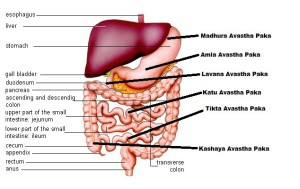Usually, six or more hours are required for food to be properly digested. The six tastes relate to each stage of digestion (there are six stages), each stage last approximately for one hour. Every taste nourishes Rasa Dhatu during its respective stage; hence Rasa dhatu contains all the six tastes.
The first stage is called Madhura Avastha Paka, or the sweet stage of digestion.
All the six tastes are present during the first hour of digestion, but the sweet taste in predominant. Sweet is composed of Water and Earth, and so the secretions provoked are Kaphagenic in nature. Kledaka Kapha is the first to be released, as food enters the stomach. Simple sugars are digested and so blood sugar rises. Food is broken into smaller pieces. During this hour the stomach is stretched until one feels no hunger, and feels satisfaction. This is Kapha stage and so it is common to feel heaviness and dullness after consuming a meal. Energy is still given by the undigested food, and it is by the fact that Rasa dhatu is being nourished.
The second stage is called Amla Avasha Paka, or the sour stage of digestion.
During this stage, which Earth and Fire predominate, the food is broken into even smaller pieces. In this stage the stomach begins to be lighter due to the Fire element. Food becomes sour because of the Hydrochloric Acid (HCL), released from the lesser curvature of the stomach. Kledaka Kapha in the stomach is in charge of protecting the stomach from not being consumed and if it is decreased heartburn, gastritis and ulcer may result. Agni secretes the sour taste into Rasa, so this stage normally will aggravate hives, rashes and skin problems. During this stage Rasa dhatu helps nourishing asthayi Rakta dhatu.
The third stage is called Lavana Avastha Paka, or the salty stage of digestion.
Food enters the duodenum. Water and Fire are the elements predominant during this stage, and create emulsification. Samana Vata, Pachaka Pitta and Ranjaka Pitta, are in charge of this stage. In the first part of the duodenum this stage relates to Mamsa dhatu, and in the latter part of the duodenum it relates to Meida dhatu. When food enters the duodenum, the gallbladder releases bile (Ranjaka Pitta), and the pancreas releases pancreatic enzymes (Kloma agni) and both get mixed with the food. This stage assists in digestion of protein and fats. If there is a low kidney energy, edema and swelling may occur in this stage. This stage nourishes asthayi mamsa dhatu and asthayi meida dhatu.
The fourth stage is called Katu Avastha Paka, or the pungent stage of digestion.
This stage takes place in the jejunum, the second part of the small intestine. Air and Fire predominates this stage. The enzymes in the upper part of the jejunum are more of the pungent taste, and have a lot of the Fire element. This causes heat and circulation, and conditions like piles, skin rashes and bleeding disorders may be irritated. The air element makes the bones porous and helps in absorption of nutrients, as well as peristalsis and production of gas. This stage nourishes Asthayi ashti dhatu.
The fifth stage is called Tikta avastha Paka, or the bitter stage of digestion.
Takes place in the ileum, last and longest part of the small intestine. Further digestion takes place here. Air and Ether are the elements predominant in this stage, and create the most absorption of food through the villi. Air stimulates Samana Vata maintaining peristalsis. Due to the lightness of Ether and Air elements, there is a false feeling of hunger in this stage; however it is not an ideal time to eat, an hour after, when the digestion is complete will be a better time. This stage cools the body and calms high Pitta disorders. This stage nourishes asthayi majja dhatu.
The sixth stage is called Kashaya Avstha Paka, or the astringent stage of digestion.
Takes place in the cecum. Air and Ether are the predominant elements in this stage. Air element helps in further absorption of nutrients, and the Earth element help in giving bulk to the stools. Liquid foodstuff becomes more and more thick. This stage is necessary for absorption of vitamins, minerals and water, and takes place in the ascending colon. Kleda is absorbed by the colon and eliminated through the kidneys and bladder as urine. This stage stimulates mass peristalsis. Apana Vata is in charge of this stage, and sends a message to the brain when the fecal matter is ready for elimination. True appetite returns during this stage. Nourishes asthayi Shukra or Artava dhatu.
Times may differ from person to person, and from constitution to constitution.


Great post- thanks for sharing this info!
You are welcome Jenny
digestion depends on PITTA AGNI ARE 4 types MANDAGANI, TRISHNAGNI, SAMAGNI, VISHAMAGNI, AND ALSO 13 TYPES 7 dhtwagni, 5 bhutagni and jadharagni.so they are also the factors of digestion.
You are more than right, digestion depends on Agni as well, you can find my post on Agni in my blog.
thanks for your comment
Very informative and well detailed. Thank you for posting this.
Thank you Jason, Follow me for some more on Ayurved anad Yoga
Can u pls say the reference of this post ..
I summarised it from Dr. Lad’s book. It’s based on knowledge from Charaka and Sushrut
Pingback: Ayurveda and Yoga for Digestion – Heidi Lynne' Yoga and Wellness